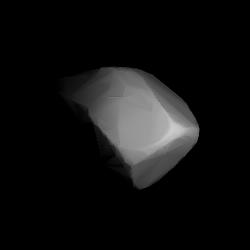2002 Euler
 Shape model of Euler from its lightcurve | |
| Discovery[1] | |
|---|---|
| Discovered by | T. Smirnova |
| Discovery site | Crimean Astrophysical Obs. |
| Discovery date | 29 August 1973 |
| Designations | |
| (2002) Euler | |
| Pronunciation | /ˈɔɪlər/[2] |
Named after | Leonhard Euler (Swiss mathematician)[3] |
| 1973 QQ1 · 1938 DW 1942 GJ · 1953 EB 1973 SJ2 | |
| main-belt · (inner) | |
| Adjectives | Eulerian /juːˈlɪəriən/[4] |
| Orbital characteristics[1] | |
| Epoch 4 September 2017 (JD 2458000.5) | |
| Uncertainty parameter 0 | |
| Observation arc | 75.04 yr (27,408 days) |
| Aphelion | 2.5844 AU |
| Perihelion | 2.2512 AU |
| 2.4178 AU | |
| Eccentricity | 0.0689 |
| 3.76 yr (1,373 days) | |
| 0.3273° | |
| 0° 15m 43.92s / day | |
| Inclination | 8.5015° |
| 178.65° | |
| 53.294° | |
| Physical characteristics | |
| 17.4 km[5] 18.838±0.066[6] | |
| Mass | 5.5×1015 kg[citation needed] |
| 5.9929 h[7][8] | |
| 0.036±0.003[6] 0.0839±0.015[5] | |
| S[7] | |
| 12.4[1] · 12.7[7] | |
2002 Euler is a stony background asteroid from the inner regions of the asteroid belt, approximately 17 kilometers (11 miles) in diameter. It was discovered on 29 August 1973, by Russian astronomer Tamara Smirnova at the Crimean Astrophysical Observatory in Nauchnyj, and assigned the prov. designation 1973 QQ1. It was named after Swiss mathematician Leonhard Euler.[3][9]
Orbit and characterization
[edit]Euler is a non-family asteroid of the main belt's background population when applying the hierarchical clustering method to its proper orbital elements. It orbits the Sun at a distance of 2.3–2.6 AU once every 3 years and 9 months (1,373 days). Its orbit has an eccentricity of 0.07 and an inclination of 9° with respect to the ecliptic.[1]
Naming
[edit]This minor planet was named after Swiss mathematician, physicist and astronomer Leonhard Euler (1707–1783). His contributions to astronomy included two theories for the motion of the Moon. Euler spent much of his time in St. Petersburg and was associated with the Russian Academy of Sciences.[3] The official naming citation was published by the Minor Planet Center on 15 October 1977 (M.P.C. 4238).[10]
Physical characteristics
[edit]Diameter and albedo
[edit]According to the surveys carried out by the Infrared Astronomical Satellite IRAS, the Japanese Akari satellite, and NASA's Wide-field Infrared Survey Explorer with its subsequent NEOWISE mission, Euler measures between 14.49 and 19.773 kilometers in diameter and its surface has an albedo between 0.0416 and 0.0839. The Collaborative Asteroid Lightcurve Link adopts Petr Pravec's revised WISE-data, that is, an albedo of 0.0375 and a diameter of 19.78 kilometers with an absolute magnitude of 12.7.[7]
References
[edit]- ^ a b c d "JPL Small-Body Database Browser: 2002 Euler (1973 QQ1)" (2017-05-01 last obs.). Jet Propulsion Laboratory. Archived from the original on 15 December 2019. Retrieved 17 June 2017.
- ^ "Euler". Oxford English Dictionary (Online ed.). Oxford University Press. (Subscription or participating institution membership required.)
- ^ a b c Schmadel, Lutz D. (2007). "(2002) Euler". Dictionary of Minor Planet Names. Springer Berlin Heidelberg. p. 162. doi:10.1007/978-3-540-29925-7_2003. ISBN 978-3-540-00238-3.
- ^ "Eulerian". Oxford English Dictionary (Online ed.). Oxford University Press. (Subscription or participating institution membership required.)
- ^ a b Tedesco, E. F.; Noah, P. V.; Noah, M.; Price, S. D. (October 2004). "IRAS Minor Planet Survey V6.0". NASA Planetary Data System. 12: IRAS-A-FPA-3-RDR-IMPS-V6.0. Bibcode:2004PDSS...12.....T. Retrieved 22 October 2019.
- ^ a b Masiero, Joseph R.; Mainzer, A. K.; Grav, T.; Bauer, J. M.; Cutri, R. M.; Dailey, J.; et al. (November 2011). "Main Belt Asteroids with WISE/NEOWISE. I. Preliminary Albedos and Diameters". The Astrophysical Journal. 741 (2): 20. arXiv:1109.4096. Bibcode:2011ApJ...741...68M. doi:10.1088/0004-637X/741/2/68. Retrieved 17 June 2017.
- ^ a b c d "LCDB Data for (2002) Euler". Asteroid Lightcurve Database (LCDB). Retrieved 17 June 2017.
- ^ Behrend, Raoul. "Asteroids and comets rotation curves – (2002) Euler". Geneva Observatory. Retrieved 17 June 2017.
- ^ "2002 Euler (1973 QQ1)". Minor Planet Center. Retrieved 17 June 2017.
- ^ Schmadel, Lutz D. (2009). "Appendix – Publication Dates of the MPCs". Dictionary of Minor Planet Names – Addendum to Fifth Edition (2006–2008). Springer Berlin Heidelberg. p. 221. Bibcode:2009dmpn.book.....S. doi:10.1007/978-3-642-01965-4. ISBN 978-3-642-01964-7.
External links
[edit]- Lightcurve Database Query (LCDB), at www.minorplanet.info
- Dictionary of Minor Planet Names, Google books
- Asteroids and comets rotation curves, CdR – Geneva Observatory,
